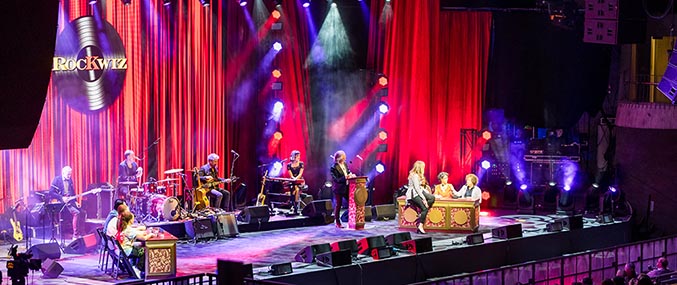



 RocKwiz’s Really Really Good Friday makes its triumphant debut at Sidney Myer Music Bowl, 12 years after RocKwiz saluted the venue as part of its 50th-anniversary celebration.
RocKwiz’s Really Really Good Friday makes its triumphant debut at Sidney Myer Music Bowl, 12 years after RocKwiz saluted the venue as part of its 50th-anniversary celebration.
Co-hosts Brian Nankervis and Julia Zemiro were joined by the RocKwiz Orkestra and The Wolfgramm Sisters as well as special guests such as Leo Sayer and Paul Dempsey.
Tim Millikan has been the live audio director for Rockwiz for years and Richie Robinson has worked with him on Rockwiz live specials going back ten years or so where he often mixed monitors. Richie also worked with Tim for six years as JPJ system tech at the Gershwin room in St Kilda in Melbourne where the TV show was filmed. Since then, Richie has mixed FOH for a lot of the one-off shows where Tim has had other bookings. This was his fourth year mixing FOH for the Really Good Friday live show as part of the Melbourne Comedy Festival.
“The music needs to feel like a rock show where you have the impact and clarity of a modern show but then you also have to balance that with the quiz part of the show where we need the dialogue to be heard,” commented Richie mixing the show. “We have one of the hosts (Julia Zemiro) on a wireless headset mic along with the other host (Brian Nankervis) on a lectern mic along with a further six lectern mics spread over the two guest/contestant desks. Finding that balance on different stages and with different PA’s is the secret to the show sounding good.”
Normally the Good Friday show has been in Hamer Hall at the Arts Centre but with Covid restrictions, the Arts Centre had most of their shows moved across the road and outdoors to the Sidney Myer Music Bowl. JPJ currently have a d&b GSL/KSL rig installed at the venue.
“The system sounded great and there were plenty of speaker boxes covering all the seats,” said Richie. “It’s a great choice for that venue as the cardioid nature of the GSL line array means a lot less spill on stage which helps clean up the tone of the headset and panel mics.”
Richie mixed on his favourite choice of console – the Avid S6L 32D – without an external Waves server or outboard gear.
“The console sounds clear and punchy and the programming and filing capabilities, in my opinion, are the most logical and stress-free of any of the current crop of consoles,” he added. “If you program a show on another size surface or engine, on another version of software or offline on the remote software, it always works when it loads. Also, the recording and virtual playback capabilities are so convenient.
“This show relies on scene automation (mainly faders, mutes and layouts) where we change back and forwards from the Quiz part of the show with the hosts, panel guests and band to the featured songs where we mute the hosts and panel guests and unmute the guest’s vocals and instruments as required. Afternoon soundchecks can be busy and require some confident programming skills and last-minute updates.”
The band were mic’d-up with the usual assortment of Shure, Sennheiser and AKG mics along with Radial DI’s that Richie prefers. Ten channels of RF was used so that everyone had their own mic for Covid protocol controls. Julia has a DPA 4088 cardioid headset mic along with a spare headset and pack. That left eight channels of handhelds with B58a heads for the guest artists, comedians and Brian’s warm-up mic. Panel mics are typically the Clockaudio C3’s with 18” stems but with Covid protocols in place, they had to have separate pop filters for each round of contestants. As they didn’t have enough on hand for the Clockaudio mics, they used Shure mx418 lectern mics instead as they were able to get plenty of pop filters for those and were also able to utilize some larger foam filters to offset their propensity for plosives at close range.
Rod Matheson mixed monitors on a DiGiCo SD10 which was the ‘house’ console. Typically, he prefers the SD5 with two screens as that allows him to customise his programming layers so he can have an inputs and an outputs view at the same time however all the JPJ SD5s had been earmarked for the Blues Fest.
The band were all on d&b M4 wedges along with a small d&b Q sub added for the drum send. Typically they all had one wedge each except for the downstage send for the guests which had four wedges. Leo Sayer used one of the house Shure PSM1000 IEM packs with just his vocal in that mix (he brought his own set of in-ears). For the dialogue portion of the show (headsets and panel mics), four L-Acoustic 108Ps, which are a coaxial self-powered speaker, were used.
“They not only sound great but they are small and easy to hide on the set or position on stands as required,” Richie said. “We used another 108P in the Stage Right offstage wing with a matrix feed from FOH so the stage managers, guests and hosts (when they were off-stage) could follow the show.”
This was Richie’s first outdoor Rockwiz show since a couple of nights at Taronga Park Zoo in Sydney in 2018 and being the start of April in Melbourne, he was concerned about whether they would have wind or rain issues which could have made it very challenging getting the dialogue part of the show to stay consistent for the audience. As it was, they had a beautiful, still, autumn day – couldn’t have asked for a better night.
Photos: Ian Laidlaw




















































